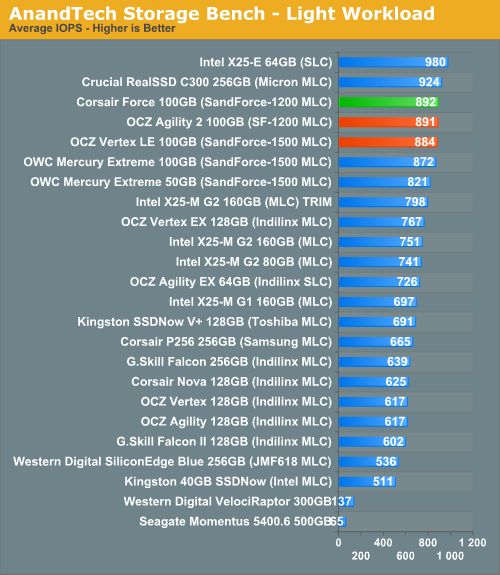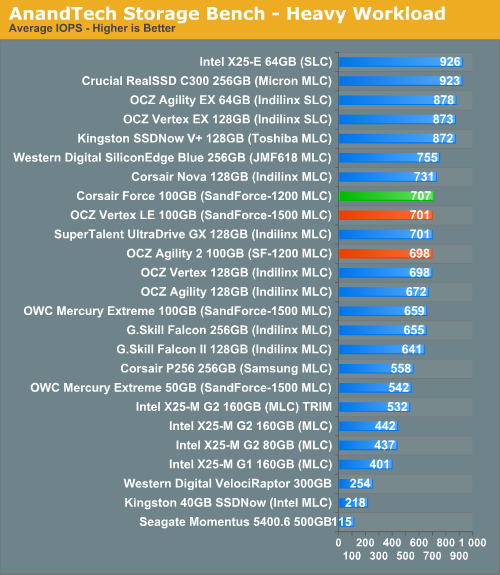OCZ's Agility 2 Reviewed: The First SF-1200 with MP Firmware
by Anand Lal Shimpi on April 21, 2010 7:22 PM ESTAnandTech Storage Bench
Note that our 6Gbps controller driver isn't supported by our custom storage bench here, so the C300 results are only offered in 3Gbps mode.
The first in our benchmark suite is a light usage case. The Windows 7 system is loaded with Firefox, Office 2007 and Adobe Reader among other applications. With Firefox we browse web pages like Facebook, AnandTech, Digg and other sites. Outlook is also running and we use it to check emails, create and send a message with a PDF attachment. Adobe Reader is used to view some PDFs. Excel 2007 is used to create a spreadsheet, graphs and save the document. The same goes for Word 2007. We open and step through a presentation in PowerPoint 2007 received as an email attachment before saving it to the desktop. Finally we watch a bit of a Firefly episode in Windows Media Player 11.
There’s some level of multitasking going on here but it’s not unreasonable by any means. Generally the application tasks proceed linearly, with the exception of things like web browsing which may happen in between one of the other tasks.
The recording is played back on all of our drives here today. Remember that we’re isolating disk performance, all we’re doing is playing back every single disk access that happened in that ~5 minute period of usage. The light workload is composed of 37,501 reads and 20,268 writes. Over 30% of the IOs are 4KB, 11% are 16KB, 22% are 32KB and approximately 13% are 64KB in size. Less than 30% of the operations are absolutely sequential in nature. Average queue depth is 6.09 IOs.
The performance results are reported in average I/O Operations per Second (IOPS):

It's not terribly surprising that we're not seeing any performance difference between the Agility 2 and other SandForce drives here. The only difference is in sustained random write performance and desktop workloads simply don't sustain purely random writes for that long a period.
If there’s a light usage case there’s bound to be a heavy one. In this test we have Microsoft Security Essentials running in the background with real time virus scanning enabled. We also perform a quick scan in the middle of the test. Firefox, Outlook, Excel, Word and Powerpoint are all used the same as they were in the light test. We add Photoshop CS4 to the mix, opening a bunch of 12MP images, editing them, then saving them as highly compressed JPGs for web publishing. Windows 7’s picture viewer is used to view a bunch of pictures on the hard drive. We use 7-zip to create and extract .7z archives. Downloading is also prominently featured in our heavy test; we download large files from the Internet during portions of the benchmark, as well as use uTorrent to grab a couple of torrents. Some of the applications in use are installed during the benchmark, Windows updates are also installed. Towards the end of the test we launch World of Warcraft, play for a few minutes, then delete the folder. This test also takes into account all of the disk accesses that happen while the OS is booting.
The benchmark is 22 minutes long and it consists of 128,895 read operations and 72,411 write operations. Roughly 44% of all IOs were sequential. Approximately 30% of all accesses were 4KB in size, 12% were 16KB in size, 14% were 32KB and 20% were 64KB. Average queue depth was 3.59.

Our heavy multitasking test definitely racks up the sequential writes, again we don't see any difference between the Agility 2 and other SandForce drives.
The gaming workload is made up of 75,206 read operations and only 4,592 write operations. Only 20% of the accesses are 4KB in size, nearly 40% are 64KB and 20% are 32KB. A whopping 69% of the IOs are sequential, meaning this is predominantly a sequential read benchmark. The average queue depth is 7.76 IOs.

Here we're completely bound by read performance.










60 Comments
View All Comments
johnlewis - Wednesday, April 21, 2010 - link
Thanks for another great article. I'm patiently waiting for a (decent) 512 GB SSD in my budget so I can just throw everything besides media files on it; 256 GB might work, if I wasn't so damn lazy. Plus, I'd rather have a half full 512 GB drive than a 90+% full 256 GB drive.retnuh - Wednesday, April 21, 2010 - link
90%+ full 256gb, I hear ya. I've been digging over as many SSD reviews as I can in the last couple days. I WANT to replace my 256gb 5400rpm in my notebook, but just can't quite squeeze everything into 200gb.gadgetguy10 - Wednesday, April 21, 2010 - link
I am waiting until the price is at least down to $1 per gigabyte for a decent ssd. I figure I can get by with about 128gb of space.retnuh - Thursday, April 22, 2010 - link
my problem is the ~120gb of development VMs, I can't get rid of them, but since I'm in vmware all day a SSD would be heaven sent for general performance. I'm keeping things pretty slim at ~190gb out of 256gb, but that 200gb mark is just too tight. I'd buy a 300gb agility 2 today if it existed.529th - Wednesday, April 21, 2010 - link
I thought the OWC controllers were discovered to have the SF 1200 controllers?Also, can we get a review on the 50g Vertex LE that are selling at New Egg, Thanks
Anand Lal Shimpi - Wednesday, April 21, 2010 - link
Those numbers are from the older OWC Mercury which used a limited run of SF-1500. The newer drives going forward are SF-1200 based. I'll be phasing them out of our graphs as a result.Take care,
Anand
dmayes - Thursday, April 22, 2010 - link
When are we going to see benchmarks on the new intel driver that's faster than microsoft's driver and it supports trim with raid and we shouldn't go off of just prices MSRP but actual newegg prices and maybe even have a low to high # for example Intel X25-M Mainstream SSDSA2MH160G2R5 ($400 - $489). Also include the 80gb version specially since its around $215 - $225Impulses - Thursday, April 22, 2010 - link
I agree on the prices... Street prices of OCZ's Indillix drives are much lower than that Corsair Nova for instance, since OCZ ALWAYS has $20-30 rebates going on their drives (and they're just cheaper to begin with)... OCZ's Nova equivalent, the Solid 2, is like $300 flat after MIR.Intel's newer SATA drivers don't enable TRIM in RAID, just w/RAID... You can have a SSD w/TRIM support and two HDD in RAID on the same controller with said drivers (something you couldn't do before), but you still can't RAID two SSD and retain TRIM support. AFAIK they didn't dramatically alter performance either but if you've got a link to tests that say otherwise I'd love to see it... I haven't bothered to install them yet.
eaw999 - Thursday, April 22, 2010 - link
but you do have to admit it is strange that imsm 8.9 was used for the testbed instead of irst 9.6. 8.9 doesn't support trim at all! one has to wonder how this might affect (or not) the benchmark scores.dmayes - Thursday, April 22, 2010 - link
"The SandForce SF-1200 controller used in the A-DATA S599 with Intel’s latest RST 9.6 drivers is the fastest 2.5 inch solid state drive for Windows users at this time. This combination is able to outperform every other drive we have tested to date in all around performance." Source tweaktown but they compared it to another 1200 drive instead of using the same ssd with both drivers. This is what intel says "Is there TRIM support for RAID configurations?Intel® Rapid Storage Technology 9.6 supports TRIM in AHCI mode and in RAID mode for drives that are not part of a RAID volume.
A defect was filed to correct the information in the Help file that states that TRIM is supported on RAID volumes."